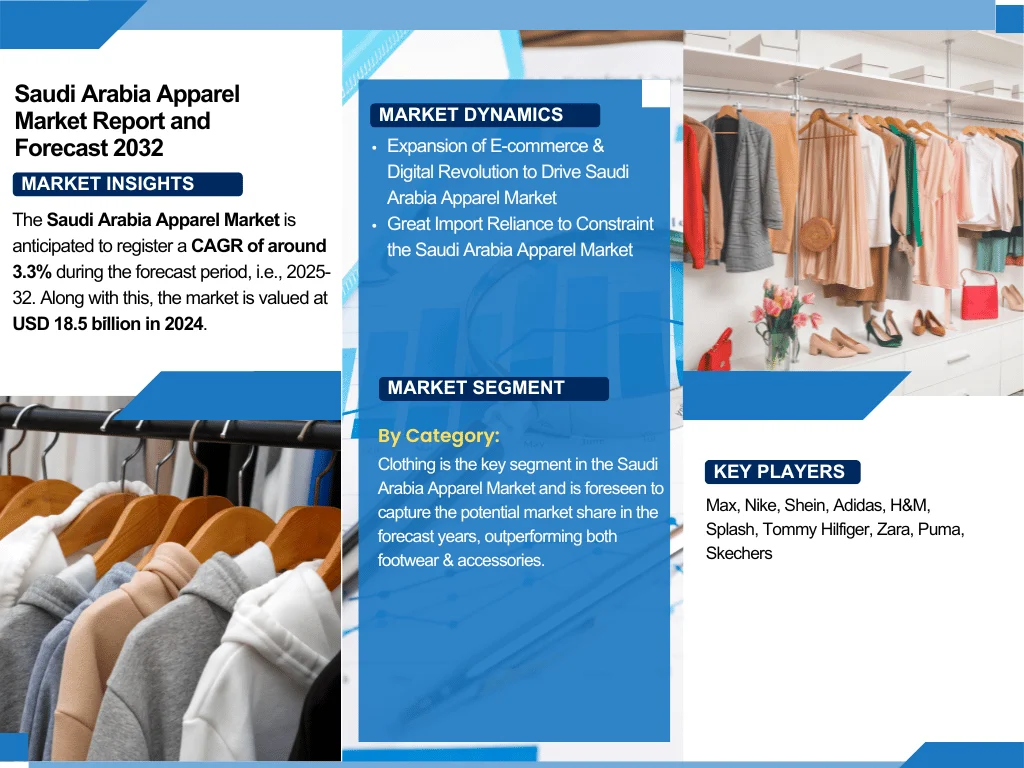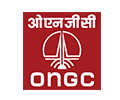Saudi Arabia Apparel Market
Source: The Report Cube
Understand The Key Trends Shaping This Market
Download Free SampleSaudi Arabia Apparel Market Insights & Analysis
The Saudi Arabia Apparel Market is anticipated to register a CAGR of around 3.3% during the forecast period, i.e., 2025-32. Along with this, the market is valued at USD 18.5 billion in 2024. The Saudi Arabia Apparel Market is a vibrant & fast-moving industry, compelled by changing consumer preferences, economic diversification attempts, and a rising young population with more disposable cash. Casual wear, formal wear, sportswear, luxury fashion, and traditional attire, including thobes & abayas are among the industry's various categories. The surge of e-commerce has had a great impact on purchasing habits, with leading online merchants & foreign companies spreading their digital presence across the Kingdom of Saudi Arabia.
Moreover, government programs like Vision 2030 have played a vital role in reshaping the retail sector by reassuring foreign investment, developing infrastructure, and mounting tourism, resulting in upscaled demand for both global & local fashion brands. Also, the Saudi Arabia Apparel Market is inclining towards sustainability, with an increasing interest in eco-friendly fabrics & ethical fashion processes. In recent years, the growing influence of Western fashion trends, combined with a preference for modest clothing, has resulted in the formation of contemporary designs that fuse tradition with modernity. Furthermore, luxury fashion producers have also revealed a profitable market in Saudi Arabia, notably in places like Riyadh & Jeddah, where high-net-worth individuals drive demand for luxury apparel & accessories.
Additionally, the rising impact of social media & influencer marketing has largely influenced fashion trends, elevating brand awareness among Saudi customers & inspiring them to embrace new styles. Also, the rapid development of shopping malls, the entry of international retail brands, and the advent of local fashion designers have generated a highly competitive industry where innovation & branding are vital for success. Further, as the economy continues to emerge, digital transformation accelerates, and cultural openness grows, the Saudi Arabia Apparel Market is set for sustained expansion, appealing both international & local brands keen to capitalize on the nation's evolving fashion landscape.
Saudi Arabia Apparel Market Dynamics
- Expansion of E-commerce & Digital Revolution to Drive Saudi Arabia Apparel Market
E-commerce & digital revolution are driving the Saudi Arabia Apparel Market. With increasing internet penetration, smartphone usage, and a tech-savvy population, online shopping has gained traction. Prominent retailers & multinational companies are enhancing their digital presence with e-commerce platforms, smartphone apps, and social media marketing. Moreover, developments in logistics, digital payment technology, and AI-powered tailored shopping experiences are making online transactions easier. Furthermore, the Saudi government's Vision 2030 project, which supports digital transformation, is hastening the sector's expansion. Therefore, the garment market is inclining towards omnichannel commerce to meet shifting customer needs.

- Great Import Reliance to Constraint the Saudi Arabia Apparel Market
The Saudi Arabia Apparel Market is hindered by its high import reliance, as the country substantially relies on foreign producers for clothes & textiles. Owing to a lack of domestic production & raw resources, the companies are exposed to global supply chain disruptions, fluctuating import prices, and trade laws. Moreover, high customs & transportation prices raise retail prices, reducing customers' affordability. While Vision 2030 steps are being implemented to enhance local manufacturing, the sector's expansion potential is still hampered by the dominance of multinational brands & reliance on imports.
Saudi Arabia Apparel Market Segment-wise Analysis
By Category:
- Clothing
- Footwears
- Accessories
Clothing is the key segment in the Saudi Arabia Apparel Market and is foreseen to capture the potential market share in the forecast years, outperforming both footwear & accessories. Furthermore, in 2024, the apparel industry is predicted to generate roughly USD 19.35 billion, with women's apparel grabbing nearly USD 7.90 billion. This dominance is reinforced by the Kingdom's plans under Vision 2030, which seek to diversify the economy & develop the fashion sector. Also, footwear & accessories, on the other hand, are anticipated to upsurge, with their market share upscaling in the coming years.

What Does Our Saudi Arabia Apparel Market Research Study Entail?
- Saudi Arabia Apparel Market Research Report highlights the forecast growth rate or CAGR by anticipating the market size & share.
- The market analysis puts light upon the primary industry trends, driving aspects, potential opportunities, growth challenges, and other major factors.
- Saudi Arabia Apparel Market Research Report entails details about the most critical shifts in market share in the prominent regions.
- Considering the statistics & the developments by the primary market competitors, our report also strives to demonstrate the most sought-after strategies of the key players.
Table of Contents
- Introduction
- Objective of the study
- Product Definition
- Market Segmentation
- Study Variables
- Research Methodology
- Secondary Data Points
- Companies Interviewed
- Primary Data Points
- Break Down of Primary Interviews
- Secondary Data Points
- Executive Summary
- Market Dynamics
- Drivers
- Challenges
- Opportunity Assessment
- Recent Trends and Developments
- Policy and Regulatory Landscape
- Saudi Arabia Apparel Market Overview (2020-2032)
- Market Size, By Value (in USD Billions)
- Market Share, By Category
- Clothing
- Footwears
- Accessories
- Market Share, By Company
- Revenue Shares
- Competition Characteristics
- Competitive Outlook (Company Profile - Partila List)
- Max
- Company Overview
- Business Segments
- Strategic Alliances/Partnerships
- Recent Developments
- Nike
- Company Overview
- Business Segments
- Strategic Alliances/Partnerships
- Recent Developments
- Nike
- Company Overview
- Business Segments
- Strategic Alliances/Partnerships
- Recent Developments
- Adidas
- Company Overview
- Business Segments
- Strategic Alliances/Partnerships
- Recent Developments
- H&M
- Company Overview
- Business Segments
- Strategic Alliances/Partnerships
- Recent Developments
- Splash
- Company Overview
- Business Segments
- Strategic Alliances/Partnerships
- Recent Developments
- Tommy Hilfiger
- Company Overview
- Business Segments
- Strategic Alliances/Partnerships
- Recent Developments
- Zara
- Company Overview
- Business Segments
- Strategic Alliances/Partnerships
- Recent Developments
- Puma
- Company Overview
- Business Segments
- Strategic Alliances/Partnerships
- Recent Developments
- Skechers
- Company Overview
- Business Segments
- Strategic Alliances/Partnerships
- Recent Developments
- Max
- Contact Us & Disclaimer
List of Figure
Figure 1: Market Segmentation Overview
Figure 2: Study Variables Framework
Figure 3: Research Methodology Flowchart
Figure 4: Secondary Data Sources Used
Figure 5: Companies Interviewed by Category
Figure 6: Breakdown of Primary Interviews by Role
Figure 7: Executive Summary - Key Market Highlights
Figure 8: Market Drivers Overview
Figure 9: Key Market Challenges
Figure 10: Opportunity Assessment Matrix
Figure 11: Recent Trends and Developments Timeline
Figure 12: Policy and Regulatory Landscape Impact on Market
Figure 13: Saudi Arabia Apparel Market Size (2020-2032) — USD Billions
Figure 14: Market Share by Apparel Category (Clothing, Footwear, Accessories)
Figure 15: Market Share by Company – Revenue Distribution
Figure 16: Competition Characteristics Overview
Figure 17: Competitive Outlook – Company Profiles Overview
Figure 18: Max – Company Overview
Figure 19: Max – Business Segments Breakdown
Figure 20: Max – Strategic Alliances and Partnerships
Figure 21: Max – Recent Developments Timeline
Figure 22: Nike – Company Overview
Figure 23: Nike – Business Segments Breakdown
Figure 24: Nike – Strategic Alliances and Partnerships
Figure 25: Nike – Recent Developments Timeline
Figure 26: Adidas – Company Overview
Figure 27: Adidas – Business Segments Breakdown
Figure 28: Adidas – Strategic Alliances and Partnerships
Figure 29: Adidas – Recent Developments Timeline
Figure 30: H&M – Company Overview
Figure 31: H&M – Business Segments Breakdown
Figure 32: H&M – Strategic Alliances and Partnerships
Figure 33: H&M – Recent Developments Timeline
Figure 34: Splash – Company Overview
Figure 35: Splash – Business Segments Breakdown
Figure 36: Splash – Strategic Alliances and Partnerships
Figure 37: Splash – Recent Developments Timeline
Figure 38: Tommy Hilfiger – Company Overview
Figure 39: Tommy Hilfiger – Business Segments Breakdown
Figure 40: Tommy Hilfiger – Strategic Alliances and Partnerships
Figure 41: Tommy Hilfiger – Recent Developments Timeline
Figure 42: Zara – Company Overview
Figure 43: Zara – Business Segments Breakdown
Figure 44: Zara – Strategic Alliances and Partnerships
Figure 45: Zara – Recent Developments Timeline
Figure 46: Puma – Company Overview
Figure 47: Puma – Business Segments Breakdown
Figure 48: Puma – Strategic Alliances and Partnerships
Figure 49: Puma – Recent Developments Timeline
Figure 50: Skechers – Company Overview
Figure 51: Skechers – Business Segments Breakdown
Figure 52: Skechers – Strategic Alliances and Partnerships
Figure 53: Skechers – Recent Developments Timeline
Figure 54: Contact Us & Disclaimer Information
List of Table
Table 1: Objectives of the Study
Table 2: Product Definitions and Specifications
Table 3: Detailed Market Segmentation
Table 4: Study Variables and Measurement Criteria
Table 5: Secondary Data Points Collected
Table 6: Companies Interviewed with Contact Details
Table 7: Primary Data Points Overview
Table 8: Breakdown of Primary Interviews by Role and Region
Table 9: Executive Summary – Key Metrics Snapshot
Table 10: Market Drivers with Impact Analysis
Table 11: Market Challenges and Their Effects
Table 12: Opportunity Assessment by Segment
Table 13: Recent Trends and Developments Summary
Table 14: Policy and Regulatory Framework Overview
Table 15: Saudi Arabia Apparel Market Size (2020-2032) — Year-wise Data (USD Billion)
Table 16: Market Share by Category (Clothing, Footwear, Accessories) — Value and Volume
Table 17: Market Share by Company – Revenue Data
Table 18: Competition Characteristics Summary
Table 19: Competitive Outlook – Summary of Company Profiles
Table 20: Max – Financial Summary and Business Segment Revenues
Table 21: Max – Strategic Alliances and Partnership Details
Table 22: Max – Recent Developments and Announcements
Table 23: Nike – Financial Summary and Business Segment Revenues
Table 24: Nike – Strategic Alliances and Partnership Details
Table 25: Nike – Recent Developments and Announcements
Table 26: Adidas – Financial Summary and Business Segment Revenues
Table 27: Adidas – Strategic Alliances and Partnership Details
Table 28: Adidas – Recent Developments and Announcements
Table 29: H&M – Financial Summary and Business Segment Revenues
Table 30: H&M – Strategic Alliances and Partnership Details
Table 31: H&M – Recent Developments and Announcements
Table 32: Splash – Financial Summary and Business Segment Revenues
Table 33: Splash – Strategic Alliances and Partnership Details
Table 34: Splash – Recent Developments and Announcements
Table 35: Tommy Hilfiger – Financial Summary and Business Segment Revenues
Table 36: Tommy Hilfiger – Strategic Alliances and Partnership Details
Table 37: Tommy Hilfiger – Recent Developments and Announcements
Table 38: Zara – Financial Summary and Business Segment Revenues
Table 39: Zara – Strategic Alliances and Partnership Details
Table 40: Zara – Recent Developments and Announcements
Table 41: Puma – Financial Summary and Business Segment Revenues
Table 42: Puma – Strategic Alliances and Partnership Details
Table 43: Puma – Recent Developments and Announcements
Table 44: Skechers – Financial Summary and Business Segment Revenues
Table 45: Skechers – Strategic Alliances and Partnership Details
Table 46: Skechers – Recent Developments and Announcements
Table 47: Contact Information and Disclaimer
Top Key Players & Market Share Outlook
- Max
- Nike
- Shein
- Adidas
- H&M
- Splash
- Tommy Hilfiger
- Zara
- Puma
- Skechers
Frequently Asked Questions








